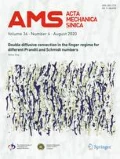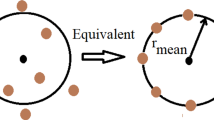Abstract
The extended finite element method (X-FEM) is a novel numerical methodology with a great potential for using in multi-scale computation and multi-phase coupling problems. The algorithm is discussed and a program is developed based on X-FEM for simulating mixed-mode crack propagation. The maximum circumferential stress criterion and interaction integral are deduced. Some numerical results are compared with the experimental data to prove the capability and efficiency of the algorithm and the program. Numerical analyses of sub-interfacial crack growth in bi-materials give a clear description of the effect on fracture made by interface and loading condition.
Similar content being viewed by others
References
Zhuang, Z., Guo, Y.J.: Analysis of dynamic fracture mechanism in gas pipelines. Engng. Fracture Mech. 64, 271–289 (1999)
Nishioka, T.: Computational dynamic fracture mechanics. Int. J. Fract. 86, 127–159 (1997)
Belytschko, T., Black, T.: Elastic crack growth in finite elements with minimal remeshing. Int. J. Numer. Meth. Engng. 45, 601–620 (1999)
Moes, N., Dolbow, J., Belytschko, T.: A finite element method for crack growth without remeshing. Int. J. Numer. Meth. Engng. 46, 131–150 (1999)
Belytschko, T., Moes, N.: Arbitrary discontinuities in finite elements. Int. J. Numer. Meth. Engng. 50, 993–1013 (2001)
Réthoré, J., Gravouil, A.: An energy-conserving scheme for dynamic crack growth using the eXtended finite element method. Int. J. Numer. Meth. Engng. 61, 631–649 (2004)
Menouillard, T., Réthoré, J., Combescure, A., et al.: Efficient explicit time stepping for the extended finite element method (X-FEM). Int. J. Numer. Meth. Engng. 68, 911–939 (2006)
Sukumar, N., Chopp, D.L., Moes, N., et al.: Modeling holes and inclusions by level sets in the extended finite-element method. Comput. Methods Appl. Mech. Engrg. 190, 6183–6200 (2001)
Belytschko, T., Chen, H.: Dynamic crack propagation based on loss of hyperbolicity and a new discontinuous enrichment. Int. J. Numer. Meth. Engng. 58, 1873–1905 (2003)
Chessa, J., Belytschko, T.: Arbitrary discontinuities in space-time finite elements by level sets and X-FEM. Int. J. Numer. Meth. Engng. 61, 2595–2614 (2004)
Chessa, J., Belytschko, T.: A local space-time discontinuous finite element method. Comput. Methods Appl. Mech. Engrg. 195, 1325–1343 (2005)
Réthoré, J., Gravouil, A.: A combined space-time extended finite element method. Int. J. Numer. Meth. Engng. 64, 260–284 (2005)
Belytschko, T., Fries, T.P.: The intrinsic XFEM: a method for arbitrary discontinuities without additional unknowns. Int. J. Numer. Meth. Engng. 68, 1358–1385 (2006)
Gravouil, A., Ribeaucourt, R., Baietto-Dubourg: A new fatigue frictional contact crack propagation model with the coupled XFEM/LATIN method. Comput. Methods Appl. Mech. Engrg. 196, 3230–3247 (2007)
Fang, X.J., Jin, F.: Extended finite element method based on ABAQUS. Engineering Mechanics. 24(7), 6–10 (2007)
Xie, H., Feng, M.L.: Implementation of extended finite element method with ABAQUS user subroutine. Journal of Shanghai Jiaotong University. 43(10), 1644–1653 (2009) (in Chinese)
John, R., Shah, S.P.: Mixedmode fracture of concrete subjected to impact loading. Journal of Structural Engineering (ASCE) 116, 585–602 (1989)
Belytschko, T., Tabbara, M.: Dynamic fracture using elementfree Galerkin methods. Int. J. Numer. Meth. Engng. 39, 923–938 (1996)
Song, J.H., Areias, P., Belytschko, T.: A method for dynamic crack and shear band propagation with phantom nodes. Int. J. Numer. Meth. Engng. 67, 868–893 (2006)
Lee, H., Krishnaswamy, S.: Quasi-static propagation of subinterfacial cracks. ASME J. Appl. Mech. 67, 444–452 (2000)
Author information
Authors and Affiliations
Corresponding author
Rights and permissions
About this article
Cite this article
Zhuang, Z., Cheng, BB. Development of X-FEM methodology and study on mixed-mode crack propagation. Acta Mech Sin 27, 406–415 (2011). https://doi.org/10.1007/s10409-011-0436-x
Received:
Revised:
Accepted:
Published:
Issue Date:
DOI: https://doi.org/10.1007/s10409-011-0436-x




